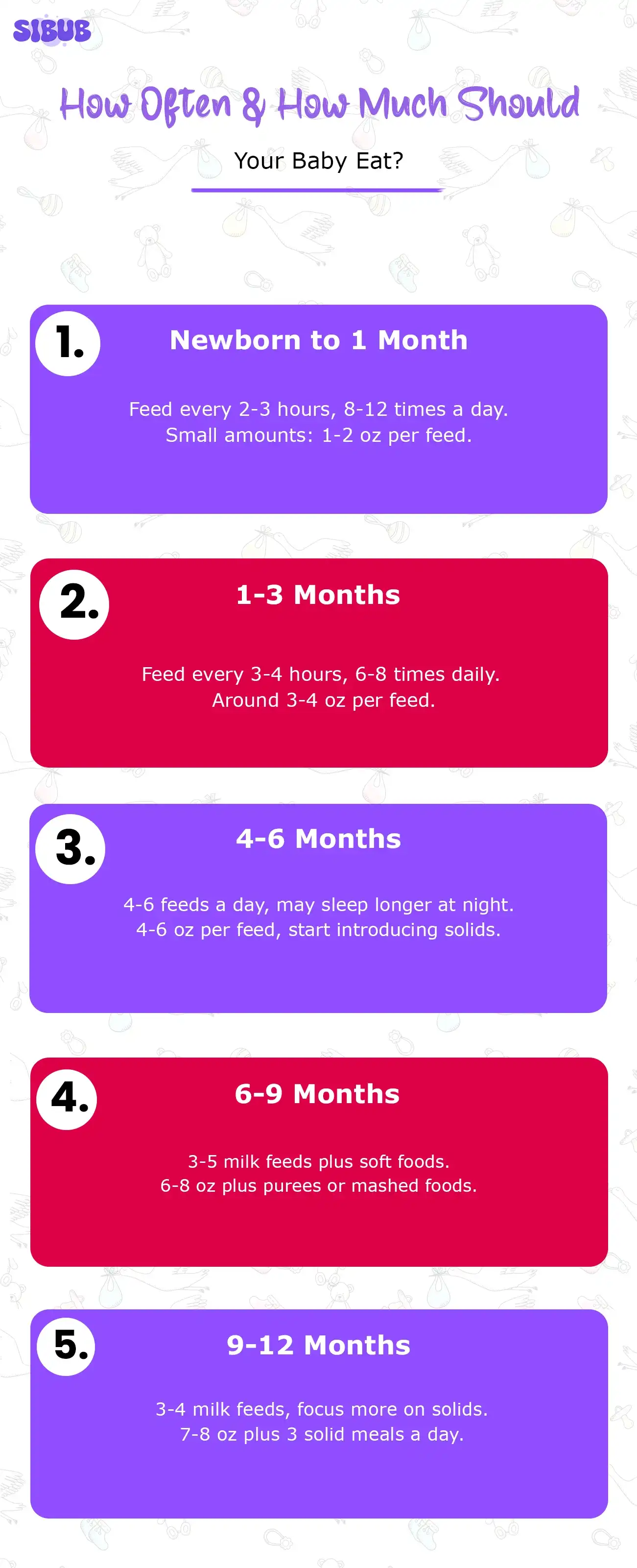Wondering how much should a one month old eat? You’re not alone. It’s one of the most common concerns new parents have. The short answer is, it depends. Babies grow quickly in the first year, and their feeding needs change just as fast. What’s “normal” for one baby may be very different for another.
That said, there are helpful patterns and feeding cues to look out for. In this post, we’ll break down everything from how many ounces should a newborn eat, how much should a one month old eat, to what a 3-month-old might need, and how often a 2-month-old really eats. Let’s make feeding your baby feel less overwhelming and more like second nature.
Reading Your Baby’s Hunger Cues
Before we get into ounces and charts, it’s important to learn how babies tell us they’re hungry. Crying is often the last sign; they’ve been trying to let you know much earlier.
Here are some early hunger cues:
- Lip-smacking or licking
- Turning their head toward you (called rooting)
- Opening their mouth
- Putting their hands near or into their mouth
- Sucking on fingers or objects
- Fussiness without a clear reason
Sometimes, your baby just wants to be held or needs a diaper change. With time, you’ll begin to tell the difference between hunger and other needs. But when in doubt, offering a feeding, especially in the first few months, is a safe place to start.

Visit: Natural ADHD Supplements for Kids: Non-Prescription Options
General Feeding Guidelines (But Remember, Every Baby’s Different)
Babies grow fast, but their stomachs start small, think the size of a walnut at birth. That’s why they eat often, especially in the early weeks. Over time, they’ll go longer between feedings and take in more milk at once.
Some babies “snack” frequently, while others tank up and sleep longer stretches. Never compare your baby to others, because what matters the most is that they’re growing, are satisfied, and the best part, they have plenty of wet and dirty diapers.
How Much Should a One Month Old Eat?
Now that your child is one month old, you must have caught your motion now, but you might still be suspicious about, “Is my baby eating enough?”
For breastfed babies:
- Expect to nurse every 2 to 3 hours, which can be 8–12 times a day.
- Most babies take in 2 to 4 ounces per feeding by this stage.
- Some sessions may be shorter, others longer; it’s totally normal.
Breastmilk digests quickly, so breastfed babies may eat more frequently than formula-fed ones. You may also notice cluster feeding, especially during the evening. This can also be considered as your baby’s way of boosting your milk supply.
For formula-fed babies:
- A one-month-old usually eats about 3 to 4 ounces every 3 to 4 hours.
- That adds up to roughly 24 to 32 ounces of formula per day.
Tip: Don’t try to “stretch” your baby’s feedings to make a schedule work. Feedings will naturally space out as your baby grows and starts sleeping longer.
Discover: Three Legged Race Guide: Rules, Strategy and Tips for Success
Feeding Chart for Newborns to Infants
If you’re the type who likes to see things laid out clearly, this chart can help. Just remember, your baby may eat slightly more or less, and that’s okay.
| Age | What | How Much | How Often |
| 0-2 days | Breast milk | Nurse every 1–3 hours | 8–12 times/day |
| Formula | 0.5–1 oz per feed | 6–10 times/day | |
| 3-7 days | Breast milk | Nurse every 2–3 hours | 8–12 times/day |
| Formula | 1–2 oz per feed | 8–12 times/day | |
| 2 weeks–1 month | Breast milk | 2–3 oz per feed | 8–12 times/day |
| Formula | 3–4 oz per feed | Every 3–4 hours |
How Much Should a 2-Month-Old Eat in 24 Hours?
By the time of 2 months old, your baby is starting to stay up for longer, sleep less, interact more, and eat more, too.
- Formula-fed babies: They usually take around 4 to 5 ounces per feeding, which totals around 24 to 32 ounces within 24 hours.
- Breastfed babies: Still nursing about 6 to 8 times a day, though sessions may be spaced further apart.
If you’re thinking of how often should a 2 month old eat, the answer is still every 3 to 4 hours, but your baby might stretch to 5 hours at night if they’re gaining weight well.

How Many Oz Should a 3 Month Eat?
Three months in, many parents notice their baby getting more efficient during feeds and sleeping a bit more.
- Formula-fed: Babies mainly eat 5 to 6 ounces per feeding, 5 to 6 times a day.
- Breastfed: Although this depends upon your milk supply as well as your baby’s pattern, still it’s around 6–8 feedings per 24 hours.
If you’re thinking it in ounces and want to know how many oz should a 3 month eat, aim for 25 to 32 oz total per day, and adjust based on hunger cues.
Explore: Authoritarian Parenting Style: Key Insights and More
Common Concerns: Overfeeding vs. Underfeeding
Can babies overeat? Yes, especially bottle-fed babies, since milk flows faster. Watch for signs like spitting up, belly discomfort, or acting overly fussy. If your baby seems full but keeps sucking, try pausing or using a pacifier for comfort.
Worried your baby isn’t getting enough? Here’s what to look for:
- Wet diapers: Expect 6+ wet diapers a day by the first week.
- Poop patterns: Breastfed babies poop often, sometimes after every feed. Formula-fed babies may go less frequently, but should still be regular.
- Steady weight gain: Your pediatrician will track this during checkups.
If your baby isn’t gaining weight or seems constantly unsatisfied, don’t wait; check in with your pediatrician early.
Breastfeeding Frequency by Age Chart
This chart shows what’s typical, but every baby is different.
| Age | Breastfeeding Frequency |
| 0–1 month | Every 2–3 hours (8–12 times/day) |
| 1–2 months | Every 3 hours (7–9 times/day) |
| 3–4 months | Every 3–4 hours (6–8 times/day) |
| 5–6 months | Every 4 hours or on demand |
Signs Your Baby Is Ready for Solid Foods
Most babies are ready around 6 months. Signs to look for:
- Sitting with minimal support
- Interest in your food
- Good head and neck control
- Loss of the tongue-thrust reflex
Start slow. Offer iron-rich foods like baby cereal, then introduce fruits, veggies, and pureed meats. But breast milk or formula should still be the main source of nutrition.
Therefore, Follow Your Baby’s Lead
There’s no one-size-fits-all schedule when it comes to baby feeding. Some babies want to eat more often, some less. Your best guide is your baby, not the clock, not a chart, not even your best friend’s baby.
Just remember:
- Keep an eye on diapers and weight gain.
- Look for hunger cues.
- Talk to your pediatrician if anything feels off.
And yes, it’s okay to ask questions. Feeding is a learning process for both you and your baby. You’re doing great.

Learn More: Top One Minute Challenges for Middle Schoolers: Fun & Easy Game Ideas
Quick Takeaway
- How much should a one month old eat? 2–4 oz every 2–3 hours.
- How many ounces should a newborn eat? Start at 0.5–1 oz, increase gradually.
- How much should a 2-week-old eat? About 2–3 oz per feeding.
- How many oz should a 2 month eat? 4–5 oz, every 3–4 hours.
- How many oz should a 3 month eat? 5–6 oz per feed, 5–6 times daily.
Feeding a baby should never be considered a confusing task. Use signals, trust your instincts, and check in with your pediatrician when needed.
You’ve got this, strong parent!
